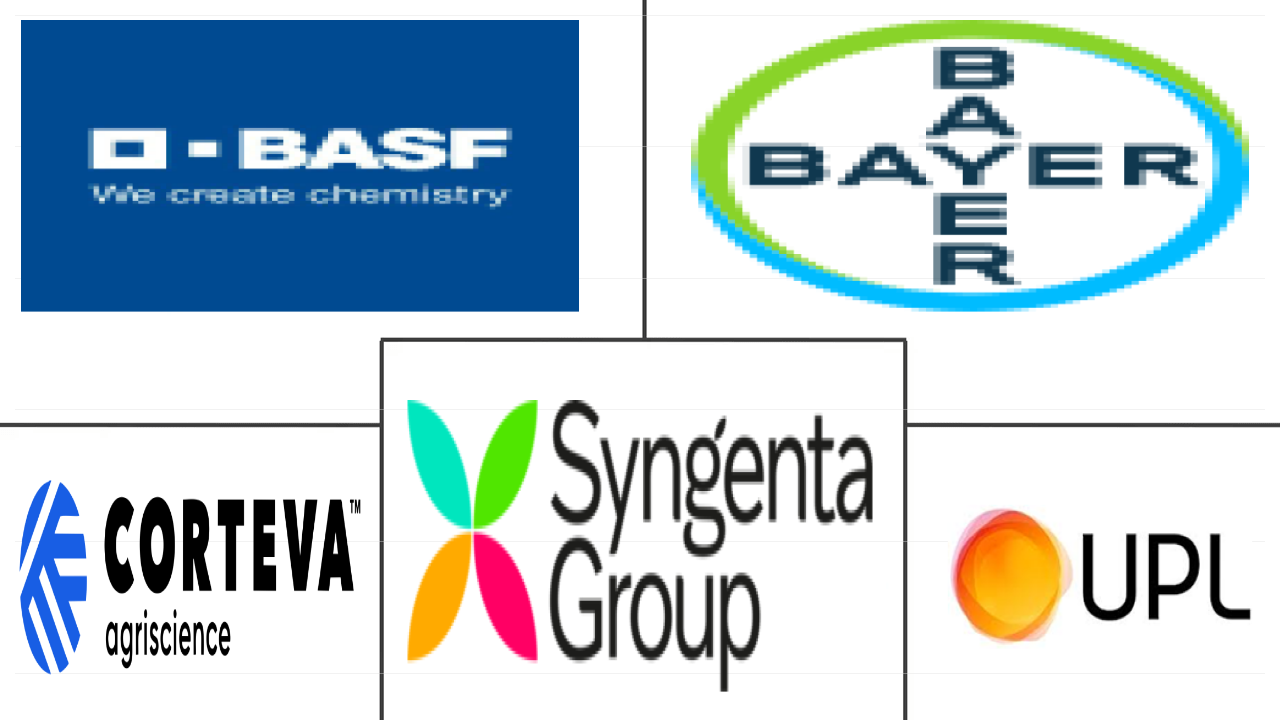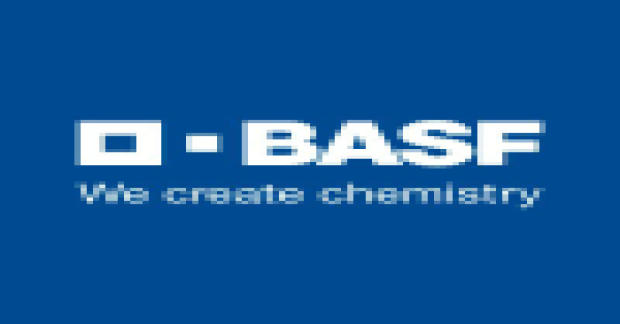Market Size of europe fungicide Industry
|
|
Study Period | 2017 - 2029 |
|
|
Market Size (2024) | USD 4.96 Billion |
|
|
Market Size (2029) | USD 5.95 Billion |
|
|
Largest Share by Application Mode | Foliar |
|
|
CAGR (2024 - 2029) | 3.72 % |
|
|
Largest Share by Country | Spain |
Major Players |
||

|
||
|
*Disclaimer: Major Players sorted in no particular order |
Europe Fungicide Market Analysis
The Europe Fungicide Market size is estimated at 4.96 billion USD in 2024, and is expected to reach 5.95 billion USD by 2029, growing at a CAGR of 3.72% during the forecast period (2024-2029).
4.96 Billion
Market Size in 2024 (USD)
5.95 Billion
Market Size in 2029 (USD)
2.35 %
CAGR (2017-2023)
3.72 %
CAGR (2024-2029)
Largest Segment by Application Mode
60.75 %
value share, Foliar, 2023
Foliar application accounted for the largest share, providing a more targeted approach, allowing efficient delivery of the fungicide to the affected plant parts.
Largest Segment by Crop Type
59.18 %
value share, Grains & Cereals, 2023
The fungicide usage in grains and cereals is driven by the need to protect crops from fungal diseases, maintain higher yields, and meet the increasing demand for food grains.
Largest Segment By Country
18.02 %
value share, Spain, 2023
Increased incidence of fungal diseases like rust, scald, and anthracnose in the major crops such as barley, olive, and wheat will drive the Spain fungicide market.
Leading Market Player 1
21.66 %
market share, Syngenta Group, 2022

Syngenta Group has focused heavily on product innovations and launched a fungicide, Orondis Plus, in the United Kingdom, which can control a broad spectrum of diseases.
Leading Market Player 2
17.67 %
market share, BASF SE, 2022

BASF SE offers around 60 fungicide products for controlling fungal diseases in major crops, including corn, cotton, canola, rape, potatoes, rice, grapes, and tree nuts.
The need for effective methods for crop protection is fueling the market’s growth in all application methods
- Europe is witnessing the growth of fungicides in various application modes to protect crops and ensure high yields. Among these modes, foliar application dominated the market, which accounted for USD 2.82 billion in 2022. This method is commonly used in various crops, including fruits, vegetables, and cereals. Farmers in Europe are increasingly recognizing the benefits of using foliar applications to protect their crops from fungal diseases, leading to higher demand for foliar methods.
- Seed treatment is expected to be one of the fastest-growing segments in the European fungicide market during the forecast period 2023-2029, registering a CAGR of 3.6%. This method provides early protection against fungal pathogens during germination and early growth stages, ensuring healthier plant establishment. The adoption of precision agriculture practices has increased in Europe. Seed treatment fits well into precision agriculture strategies, as it allows for the efficient use of fungicides while reducing wastage.
- The chemigation method is anticipated to register a CAGR of 3.4% during 2023-2029. The expansion of area under drip irrigation with the rising adoption of micro-irrigation is driving the growth of this segment.
- The market value of soil treatment is expected to increase by USD 90.9 million during the forecast period (2023-2029). The rising recognition among farmers and agricultural stakeholders regarding the significance of soil health and its influence on crop productivity is driving the demand for fungicides. Thus, the European fungicide market is expected to witness a CAGR of 3.7% during the forecast period (2023-2029).
Spain dominates the European fungicide market
- The fungicides market in Europe witnessed steady growth during the historical period, with the region occupying a share of 28.4% by value of the global fungicides market in 2022. Prothioconazole is the most commonly used fungicide in the region.
- Wheat is by far the most important crop throughout Europe. The region is the world's largest wheat producer and contributed 139 million metric tons in 2021. Fungicides are primarily used in grains and cereals in the region, as Europe is also the largest exporter and producer of staple grains. The grains and cereals segment occupied a market share of 59.2% by value in 2022.
- France, Italy, and Spain account for approximately 64% of the total use of fungicides in Europe. Spain held the largest share of 18.1% by value in 2022. This is due to the predominance of these countries in the production of major crops, such as wheat and corn. However, diseases like grape late blight, early blight, powdery mildew, downy mildew, Fusarium wilting, Septoria, and bacterial blight are the common diseases attacking major crops in the region. The occurrence of fungicide resistance presents a significant challenge as it limits fungicide choices for effective disease management. Governments of various countries, such as Russia and the Netherlands, are investing in research initiatives to discover new diseases and effective fungicides to combat them, along with launching supportive schemes for farmers.
- Such policies initiated by governments and a rise in awareness among farmers have further encouraged the adoption of crop protection practices. Such factors are expected to contribute to the market's growth, which is anticipated to record a CAGR of 3.7% during the forecast period (2023-2029).
Europe Fungicide Industry Segmentation
Chemigation, Foliar, Fumigation, Seed Treatment, Soil Treatment are covered as segments by Application Mode. Commercial Crops, Fruits & Vegetables, Grains & Cereals, Pulses & Oilseeds, Turf & Ornamental are covered as segments by Crop Type. France, Germany, Italy, Netherlands, Russia, Spain, Ukraine, United Kingdom are covered as segments by Country.
- Europe is witnessing the growth of fungicides in various application modes to protect crops and ensure high yields. Among these modes, foliar application dominated the market, which accounted for USD 2.82 billion in 2022. This method is commonly used in various crops, including fruits, vegetables, and cereals. Farmers in Europe are increasingly recognizing the benefits of using foliar applications to protect their crops from fungal diseases, leading to higher demand for foliar methods.
- Seed treatment is expected to be one of the fastest-growing segments in the European fungicide market during the forecast period 2023-2029, registering a CAGR of 3.6%. This method provides early protection against fungal pathogens during germination and early growth stages, ensuring healthier plant establishment. The adoption of precision agriculture practices has increased in Europe. Seed treatment fits well into precision agriculture strategies, as it allows for the efficient use of fungicides while reducing wastage.
- The chemigation method is anticipated to register a CAGR of 3.4% during 2023-2029. The expansion of area under drip irrigation with the rising adoption of micro-irrigation is driving the growth of this segment.
- The market value of soil treatment is expected to increase by USD 90.9 million during the forecast period (2023-2029). The rising recognition among farmers and agricultural stakeholders regarding the significance of soil health and its influence on crop productivity is driving the demand for fungicides. Thus, the European fungicide market is expected to witness a CAGR of 3.7% during the forecast period (2023-2029).
| Application Mode | |
| Chemigation | |
| Foliar | |
| Fumigation | |
| Seed Treatment | |
| Soil Treatment |
| Crop Type | |
| Commercial Crops | |
| Fruits & Vegetables | |
| Grains & Cereals | |
| Pulses & Oilseeds | |
| Turf & Ornamental |
| Country | |
| France | |
| Germany | |
| Italy | |
| Netherlands | |
| Russia | |
| Spain | |
| Ukraine | |
| United Kingdom | |
| Rest of Europe |
Europe Fungicide Market Size Summary
The European fungicide market is experiencing steady growth, driven by the increasing need to protect crops from fungal diseases and ensure high agricultural yields. The market is characterized by various application methods, with foliar application being the most dominant due to its effectiveness in protecting fruits, vegetables, and cereals. The adoption of seed treatment is rapidly growing, aligning with the rise of precision agriculture practices, which emphasize efficient resource use. The market is also witnessing expansion in chemigation and soil treatment segments, as farmers recognize the importance of soil health and the benefits of advanced irrigation techniques. The region's significant contribution to global wheat production and its status as a leading exporter of staple grains further underscore the critical role of fungicides in maintaining crop quality and yield.
The European fungicide market is moderately consolidated, with major players like BASF SE, Bayer AG, Corteva Agriscience, Syngenta Group, and UPL Limited dominating the landscape. These companies are actively innovating and expanding their product offerings to address the challenges posed by fungal diseases and resistance. The market's growth is supported by government initiatives and increased awareness among farmers about the importance of crop protection. The rising economic losses due to crop diseases, coupled with climatic changes and invasive fungal species, are driving the demand for fungicides. As a result, the market is poised for continued expansion, with a focus on developing effective solutions to combat prevalent diseases and enhance agricultural productivity.
Europe Fungicide Market Size - Table of Contents
-
1. MARKET SEGMENTATION (includes market size in Value in USD and Volume, Forecasts up to 2029 and analysis of growth prospects)
-
1.1 Application Mode
-
1.1.1 Chemigation
-
1.1.2 Foliar
-
1.1.3 Fumigation
-
1.1.4 Seed Treatment
-
1.1.5 Soil Treatment
-
-
1.2 Crop Type
-
1.2.1 Commercial Crops
-
1.2.2 Fruits & Vegetables
-
1.2.3 Grains & Cereals
-
1.2.4 Pulses & Oilseeds
-
1.2.5 Turf & Ornamental
-
-
1.3 Country
-
1.3.1 France
-
1.3.2 Germany
-
1.3.3 Italy
-
1.3.4 Netherlands
-
1.3.5 Russia
-
1.3.6 Spain
-
1.3.7 Ukraine
-
1.3.8 United Kingdom
-
1.3.9 Rest of Europe
-
-
Europe Fungicide Market Size FAQs
How big is the Europe Fungicide Market?
The Europe Fungicide Market size is expected to reach USD 4.96 billion in 2024 and grow at a CAGR of 3.72% to reach USD 5.95 billion by 2029.
What is the current Europe Fungicide Market size?
In 2024, the Europe Fungicide Market size is expected to reach USD 4.96 billion.

